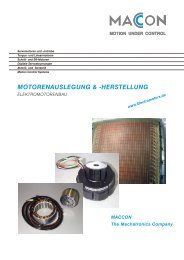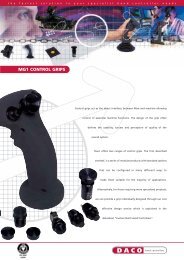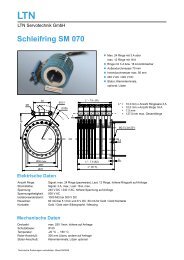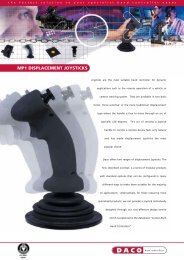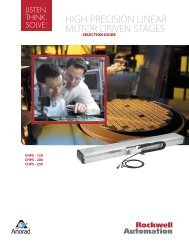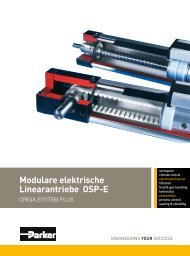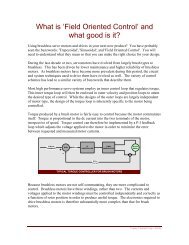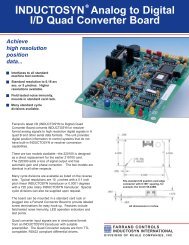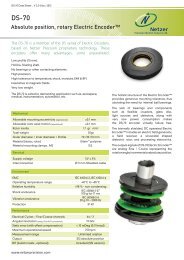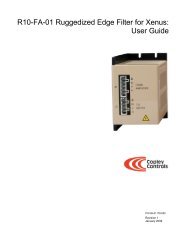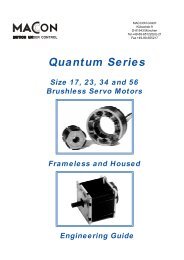AN-05;Accuracy, Resolution, and Repeatability - Netzer
AN-05;Accuracy, Resolution, and Repeatability - Netzer
AN-05;Accuracy, Resolution, and Repeatability - Netzer
- No tags were found...
You also want an ePaper? Increase the reach of your titles
YUMPU automatically turns print PDFs into web optimized ePapers that Google loves.
Thus, increasing the number k would decrease the quantization noise by a factor of √k <strong>and</strong> increasethe resolution by log 2 √k bits.Over‐sampling particularly suits the Electric Encoder with its typical 1kHz b<strong>and</strong>width since A/Dconverters can easily sample at least 100 times the required Nyquist rate thus improving quantizationnoise by a factor of √100=10. This would be equivalent to increasing the A/D converter resolution byLog 210 i.e., 3 extra bits e.g. converting a 12‐bit A/D converter into a 15‐bit converter.It is important to notice that from the st<strong>and</strong>point of the A/D converter the encoder noise isindistinguishable from its signal <strong>and</strong> the above analysis does not apply to it, it can only be reduced bylimiting the signal b<strong>and</strong>width. In applications where the full b<strong>and</strong>width of the encoder is not neededthis b<strong>and</strong>width reduction may be implemented by either analog low pass filtering of the input signalsor by increasingly averaging the A/D converter output samples.Also, instead of averaging the A/D converter output codes it is preferable to average the decodedangle obtained from the look‐up table. In fact this provides two potential advantages: 1. Reducing theloading on the CPU. 2. The required look‐up table stays the same <strong>and</strong> fit the A/D converter outputcodes rather than the enhanced resolution obtained by averaging.5. Electric Encoder errors – generalThe error components of the Electric Encoder can be characterized by revolution errors <strong>and</strong> cycleerror. Revolution errors result from imperfect rotational symmetry of the stator <strong>and</strong> rotor relative tothe mechanical rotation axis, such as eccentricity, warp, or tilt. Cycle errors are due to imperfectionsin the Sine <strong>and</strong> Cosine signals <strong>and</strong> comprise harmonics of the EC (electric cycle): 1st harmonic error,2nd <strong>and</strong> the 4th harmonic errors.The number of 1st harmonic cycles in one revolution is the same as the number of the encoderEC/R’s <strong>and</strong> is a result of the sine <strong>and</strong> cosine offset voltages. The dashed circle in Figure 6‐a belong tothe “ideal” signals with no offset, while the blue circle represents the actual measured sine <strong>and</strong>cosine of the electrical angle with the red phasor represents the offset components. It is evident thatat the two electrical angles where the two phasors are nearly collinear the decoded angle will not beaffected by the offset while at the electrical angles where the two are nearly perpendicular the errorwill reach its maximum value of o/P radians, where o is the offset phasor length <strong>and</strong> P is the peakamplitude of the encoder outputs. Thus an offset voltage of 1mV <strong>and</strong> a peak signal of 500mV willresult in an electrical angle error of 1/500=2mRad, which with 32 EC/R will translate into amechanical error of 2/32mRad.Figure 6(b)(a)www.netzerprecision.com Application Note <strong>05</strong> – <strong>Accuracy</strong>, <strong>Resolution</strong>, <strong>and</strong> <strong>Repeatability</strong> 5 / 11



